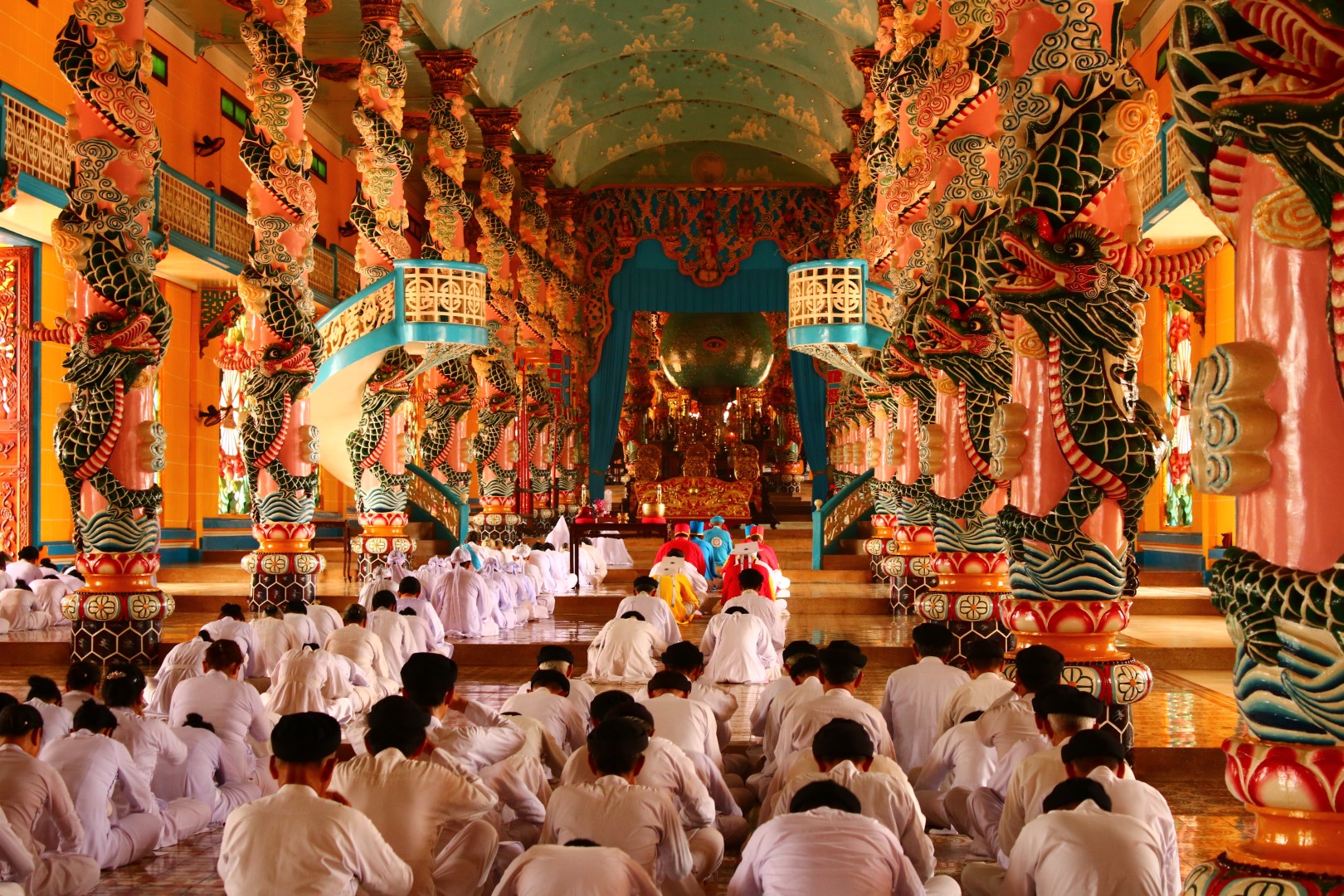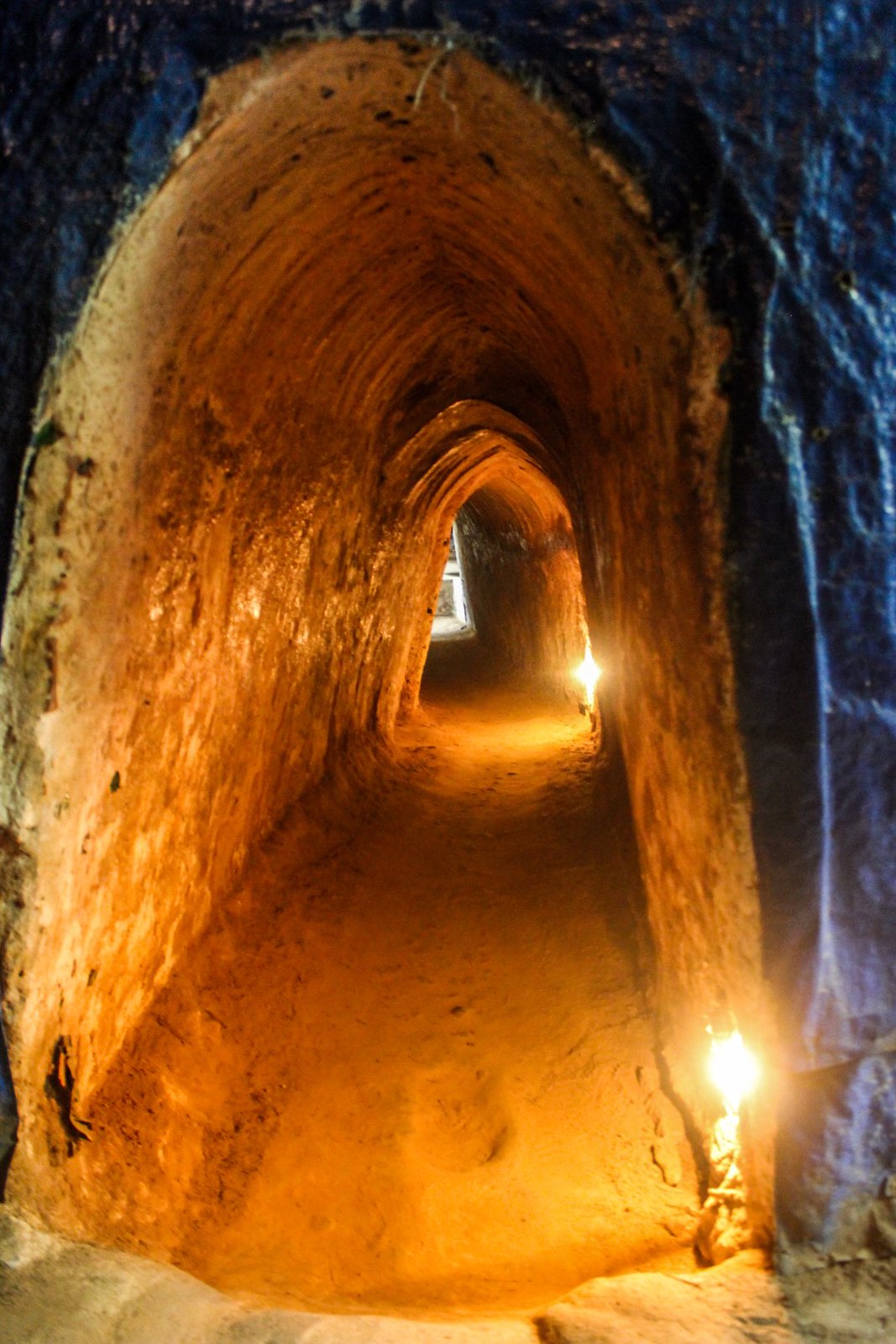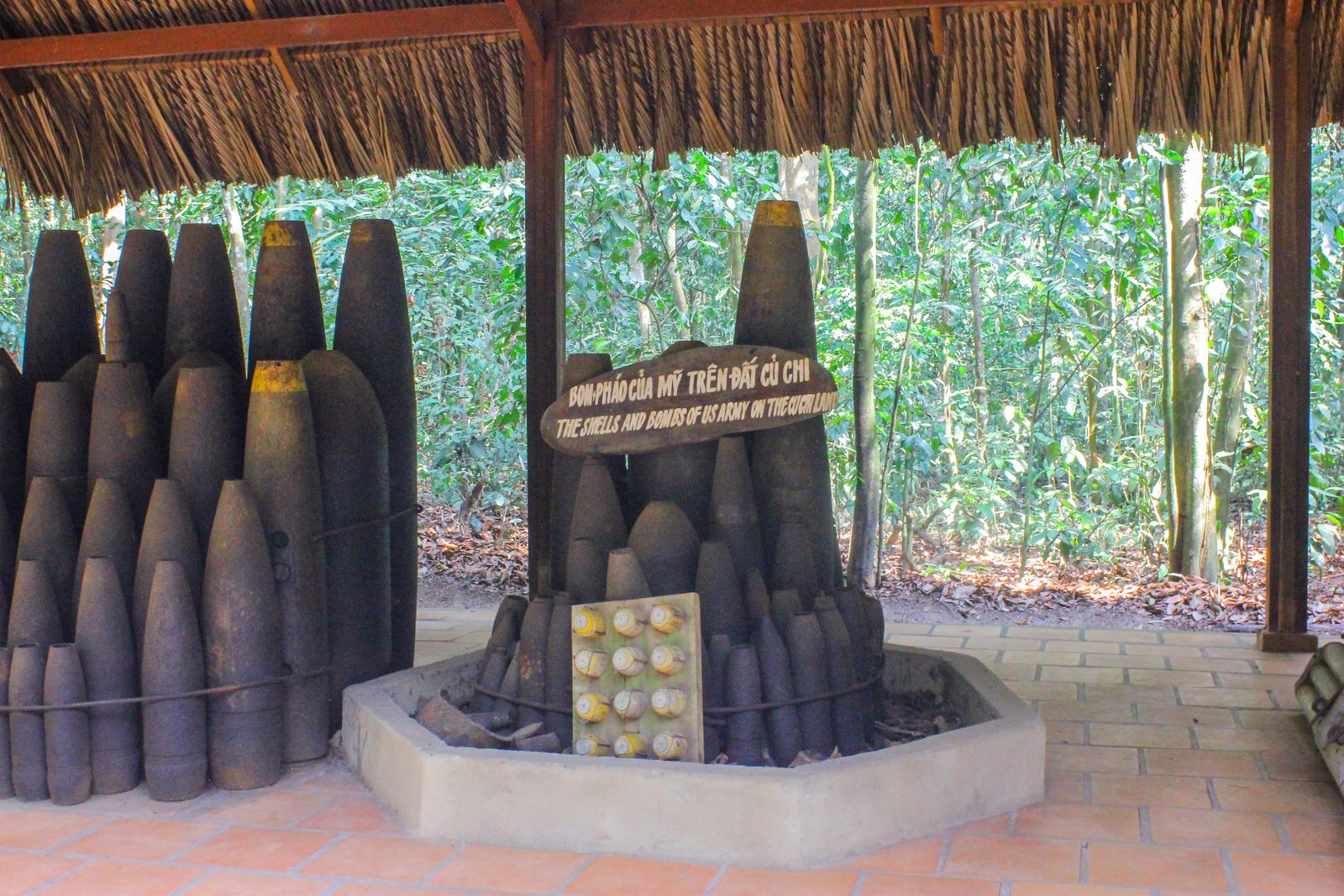
Awaken again to the sounds of earthworks in the vacant lot next door. Shower, pack, breakfast, check out – in that order. A big day today. Off to Cu Chi and Tay Ninh, then checking in to our new hotel close to the airport ready for our next leg tomorrow.
Traffic is astoundingly slow this morning, as we head north to the Cu Chi tunnels. Huge trucks have pulled up and parked in one of the lanes of the highway, forcing everyone else across the lanes around them. It’s agonisingly slow. Motorbikes take to the footpaths and whatever gaps they can find to avoid the gridlock. Wednesday morning in Saigon. Long fills the time by telling us about the Tunnel Rats – Australian, New Zealand and American soldiers who dove into the tunnels, to kill Viet Cong guerrillas. My knowledge of the Australian involvement in the Vietnam War is embarrassingly lacking. Long recounts as many gory details as he can recall.
Arrive at the tunnels, and find there is barely another soul around. Long explains that there are two sites you can visit to see the Cu Chi tunnels: Truong Ban and Ben Duoc. The big tourist buses go to Truong Ban, we’re at Ben Duoc. Long says Truong Ban is always crowded, there’s not as many tunnels to look in and it’s less interactive. Here at Ben Duoc, there’s more tunnels to crawl through, better displays, and more space. In the distance I can hear the popping of gun fire, which Long assures me is just the firing range. Tourists can shoot weapons here, he says with a sigh. I assure him its not something we’re into, and he smiles. I wonder how many tourists visit the gun range here, with total disregard for this place and what it stands as reminder of.

We follow Long into the jungle on a well worn path. He points out an ant mound – this is how the VC hid the ventilation shafts for the tunnels. The VC were also masters of moving without noise – something I was terrible at. I’d be a sitting duck in guerrilla warfare. Under a thatched roof shelter, there’s a cross-section display of the tunnel system here. It’s not just a series of tunnels and sniper holes. The place was virtually a thriving city under ground. Family rooms, a hospital, nursery, kitchens – all amongst the booby trap pits and secret escapes. Ventilation shafts lead for hundreds of metres away from the tunnel themselves, hidden under the ant mounds, to disguise the tunnels. Cooking was done at night, so the smoke wouldn’t be seen, and the kitchen chimneys could be up to a kilometre away from the kitchen itself. Tunnels were dug by hand. Long held up a bomb fragment shaped like a scoop, explaining that the Viet Cong used whatever they had and could find.
Before heading into the tunnels, Long takes us to another thatched roof shelter to watch an ancient film. “Propaganda film”, he jokes. He feigns worry at the thought of some of the Cu Chi tunnels staff hearing him. None of them seem interested. The film shows footage of the tunnels in use during the conflict, describing the Americans as Imperialist forces. South Vietnamese were the rebels, the dissidents, co-conspirators with the Imperialists. Long wasn’t joking. Outside the shelter, there was three mannequins dressed in the uniforms of the Viet Cong; lightweight cotton and deep blue. Camouflage sheet, which they used for shelter, and rubber sandals. The sandals were designed to ‘face backward’ to make it look like the soldiers were walking in the opposite direction, and throwing trackers off. While we follow Long back into the jungle, I think about the wasteful nature of the Western forces, compared to the ingenuity and use and reuse attitude of the North Vietnamese Army and the Viet Cong.

Despite the air ventilation, it is still suffocatingly cramped and hot inside the tunnels. We crawl through a few sections – literally crawl. Long explains what each section connects to, and how long it is. My only saving grace is it is too dark to really see how tiny the spaces are. Praise your preferred deity. Apparently the tunnels have been widened to accommodate foreigners. I want to know where. This news left me wondering how tiny, terrifying and crowded the tunnels really were. The command room is pitch black; it’s so dark I think I can smell the darkness. I notice myself trying to open my eyes wider, and walking with my hands out looking for a touch point. It’s so disorientating, I have no idea how anything got done down here. Long lights up the maps on the wall with his phone, pointing out the markers which note American forces, South Vietnamese forces and supply chains. The medical centre gives me the heebeejeebees as Long reels off the items available to surgeons in these holes (not many) and the survival rate (not very good). “Medical centre is nearest to the entry, to get the fresh air”, explains Long. What fresh air?
Finally resurface, squinting in the sunlight. How does one kill sunlight? Asking for a friend.
Long walks us past a series of booby trap displays, explaining how each of them work. Trap doors, bamboo stakes, rebar sharpened into barbs. We squirm as he describes the injuries they caused, and admits “this is very unpleasant, but this was reality”. One of the worst was the ‘souvenir trap’, which once it has ensnared its victim was impossible to remove without surgical or hardware intervention. It was the War Remnants Museum all over again – how do humans do this to each other? It was fascinating, but also tragic and macabre. I leave with a sense of amazement (the sheer ingenuity of the tunnels) but also disgust (the booby traps). Conflicted. The final, devastating image from the tunnels is the range of artillery shells and bomb casings on display. Cluster bombs, phosphorous bombs, enormous shells taller than me stand silently, like morbid families gathered for photos. Bringers of death. The casings, which are still whole, are a fraction of what has been found in the area and have been disarmed. The toll from the war is never-ending; local people, including children, pick up the bombs and the mines without realising their danger. The results are horrific.

Leaving Ben Duoc, we make a run through the backstreets to the Cao Dai Holy See at Tay Ninh. We’re both avoiding traffic, and following a route that the tour company hasn’t taken in almost 18 months. We specifically requested this itinerary, and it’s not one they are asked for frequently. There’s a couple of missed turns, a check of Google maps and a double back, but we’re on the right track. Long cheerfully relays facts about Caidaoism from the front seat as we pelt along. Caidaoism mixes influences from many religions, including Catholicism, Buddhism and Taoism. Long assures us they are very peaceful – “they are very happy for us to see their ceremonies, they want to share their religion with everyone” he says. According to Long, all Cao Dai temples look the same, its just their size that differs. I suddenly notice how many of the temples are whizzing by the window. Every few kilometres there was another smaller replica of the original Holy See temple.
Arrive at the Holy See temple, and notice the number of people dressed in what looks like white cotton pajamas walking along the road. The temple is inside a huge complex which includes dormitories, schools, libraries and the main temple itself. The temple is long and rectangle, rather incongruos, with a mash of different architectural styles. Notre Dame style bell towers at the front, a squat round tower in the middle, and a spire-topped tower at the back. Everything is trimmed with delicate, East Asian style. The walls are painted a creamy yellow, with a pitched tile roof in pinkish-red. There were saints on the front, trimmed in blue, and green and gold oriental lattice windows. It looks like a cake with fancy icing. Everyone took their shoes off at the road, before walking across a colourful rug to the door. A wizened old man in a white outfit and a black armband grins at us, and waves us in. Inside is even more colourful and grand than the outside. Yellow walls, blue trims. The ceiling is painted like a blue sky, with wispy clouds. The columns are pink, with a writhing green scaled dragon wrapped around each one. Worshippers sit on the floor in neat rows and face the back of the temple. Ahead of them, a huge glittering blue orb with a human eye painted on it – “the left eye of God”, whispers Long. Worshippers wear white, and the leaders of the clergy wear yellow, red or blue depending on their status. The hall is silent, except for the sound of the oscillating fans on the walls. We perch on a mezzanine balcony, overlooking the congregation.

A gong is struck, they bow forwards and Long whispers “now they will sing prayers, like from the bible”. Music strikes up, echoing a little through the temple. Long says they pray this way four times a day: 6am, noon, 6pm and midnight. We share the balcony with a few other tourists, as well as worshippers chosen for the choir and the musicians. There was piano, bongo drums, guitars and what looked like an Indonesian gamelan. The music is jaunty, and seems disjointed and at odds with my Western tuned ears at first. The choir starts, and it flows beautifully. Like silk, but thick like molasses. The congregation below joins in. They sing for ten minutes, before falling silent and bowing again while the gong is struck. Then it starts over again. I snap a few shots, mindful I’m encroaching on a place of worship and I am guest. Hover to one side and attempt to make as little noise as possible. I’m struck by one of the choir singers – a round faced Vietnamese girl, with shiny black hair and great fat tears streaming down her cheeks as she sings. Each break she takes a few deep breaths and wipes her face with sleeve. I think about her for the rest of the day. So strikingly moved by the moment. Or maybe she was just having a bad day.
Back on the road, heading back to Ho Chi Minh City. We stop at a local restaurant for lunch, which looks like it started as a shop out the front of the house and got away on them. There’s more tables than you could hope to count – large, long, small, square, even a table up a tree. I kind of want to go up. The kitchen is run by a family, who churn out dishes with astounding efficiency. Ceiling fans belt out as much breeze as they can muster – the air is stiflingly hot. We sit next to a fish tank where a huge fish patrols back and forth. Order ginger chicken, beef loc lac, steamed rice and spring rolls, by writing the menu numbers on a piece of paper. The food was delicious, served quickly and piping hot. Drinks are a serve yourself arrangement, where we fetch our own drinks from the fridge. The bill comes to AUD$10 for the lot.
Stuffed with lunch, and suffering a touch of heat stroke, I sleep most of the way back to Ho Chi Minh City.
Notes:
- Ben Duoc was quiet and there was heaps to see. We definitely skipped over some bits because I was struggling with the small spaces underground, and we were on a time crunch with the Cao Dai temple visit.
- The Cu Chi tunnels are not for the faint of heart. They are small, dark and cramped. Take your time, and rest when you need to. They’re scary, but its really worth it!
- If you’re visiting the Cao Dai temple, make sure you dress respectfully. Women should cover their knees and shoulders – don’t show up in your bikini (even though the humidity pretty much dictates it). Men should ensure their shoulders are covered too.
- Caodaists have strict rules where you can and can’t walk and move to around their temple. For example, you can’t walk across the front of the temple while the worship ceremony is in session. Be mindful that you may be asked to move, or not walk through certain areas.
Enjoying my diary series? You can find the other Vietnam Diary entries here, or catch up on my Cambodian adventures!